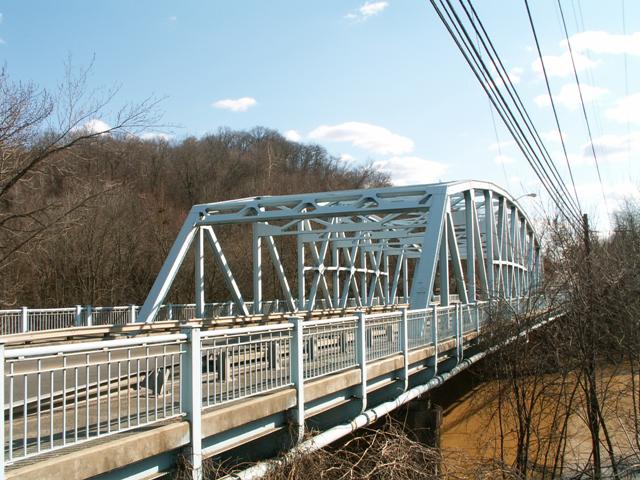We Recommend:
Bach Steel - Experts at historic truss bridge restoration.
Rockwood Avenue Bridge

Primary Photographer(s): Nathan Holth and Rick McOmber
Bridge Documented: March 3, 2007
Chesapeake: Lawrence County, Ohio: United States
Metal 9 Panel Rivet-Connected Parker Through Truss, Fixed and Approach Spans: Metal Stringer (Multi-Beam), Fixed
1933 By Builder/Contractor: Lackawanna Bridge Company of Buffalo, New York
1990
162.0 Feet (49.4 Meters)
348.0 Feet (106.1 Meters)
34 Feet (10.36 Meters)
1 Main Span(s) and 3 Approach Span(s)
4400038

View Information About HSR Ratings
Bridge Documentation
View Archived National Bridge Inventory Report - Has Additional Details and Evaluation
This bridge is a good and uncommon surviving example of a state standard truss bridge in Ohio. Utilizing i-beams for its members rather than built-up members that might include attractive v-lacing or lattice, this is a rather simple looking truss bridge, particularly for a 1933 example. Only the top chord and end post features lattice, which occurs on its underside. On the other hand, this is indeed a bridge that is unlike any modern bridge that might be built in its place, offering much more intricacy and history than a modern bridge would. Given the bridge's good condition, it is logical to continue to maintain this structure for both fiscal and aesthetic reasons.
Information and Findings From Ohio's Historic Bridge InventorySetting/Context The bridge carries a 2 lane road and sidewalks over a stream in an area dominated by a mix of early- to late-20th century residential and commercial development in Chesapeake. Physical Description The 4 span, 348'-long bridge has a 162'-long Parker thru truss main span flanked by steel stringer approach spans. The truss has riveted connections, built-up chords, and rolled section diagonals and verticals. The cantilevered sidewalks have tubular railings with metal panels. Summary of Significance The 4 -span, Parker thru truss bridge was built in 1933 by the state highway department. It is a late example of what was by 1933 a very common bridge type and design. The bridge is traditionally composed and
exhibits no innovative or distinctive details. Because it is a common solution to a long-span crossing, neither the bridge nor its contexts are historically or technologically significant. It is representative of a bridge type and
design as well as methods of fabrication that had been used for span lengths greater than 100' since the last quarter of the 19th century. Other state highway department bridges of the 1920s to 1940s better represent the
significance of the technology and standardized approach to its application in the development of the state highway system. Bridge Considered Historic By Survey: No |
![]()
Photo Galleries and Videos: Rockwood Avenue Bridge
Bridge Photo-Documentation
A collection of overview and detail photos. This photo gallery contains a combination of Original Size photos and Mobile Optimized photos in a touch-friendly popup viewer.Alternatively, Browse Without Using Viewer
![]()
Maps and Links: Rockwood Avenue Bridge
Coordinates (Latitude, Longitude):
Search For Additional Bridge Listings:
Bridgehunter.com: View listed bridges within 0.5 miles (0.8 kilometers) of this bridge.
Bridgehunter.com: View listed bridges within 10 miles (16 kilometers) of this bridge.
Additional Maps:
Google Streetview (If Available)
GeoHack (Additional Links and Coordinates)
Apple Maps (Via DuckDuckGo Search)
Apple Maps (Apple devices only)
Android: Open Location In Your Map or GPS App
Flickr Gallery (Find Nearby Photos)
Wikimedia Commons (Find Nearby Photos)
Directions Via Sygic For Android
Directions Via Sygic For iOS and Android Dolphin Browser
USGS National Map (United States Only)
Historical USGS Topo Maps (United States Only)
Historic Aerials (United States Only)
CalTopo Maps (United States Only)

